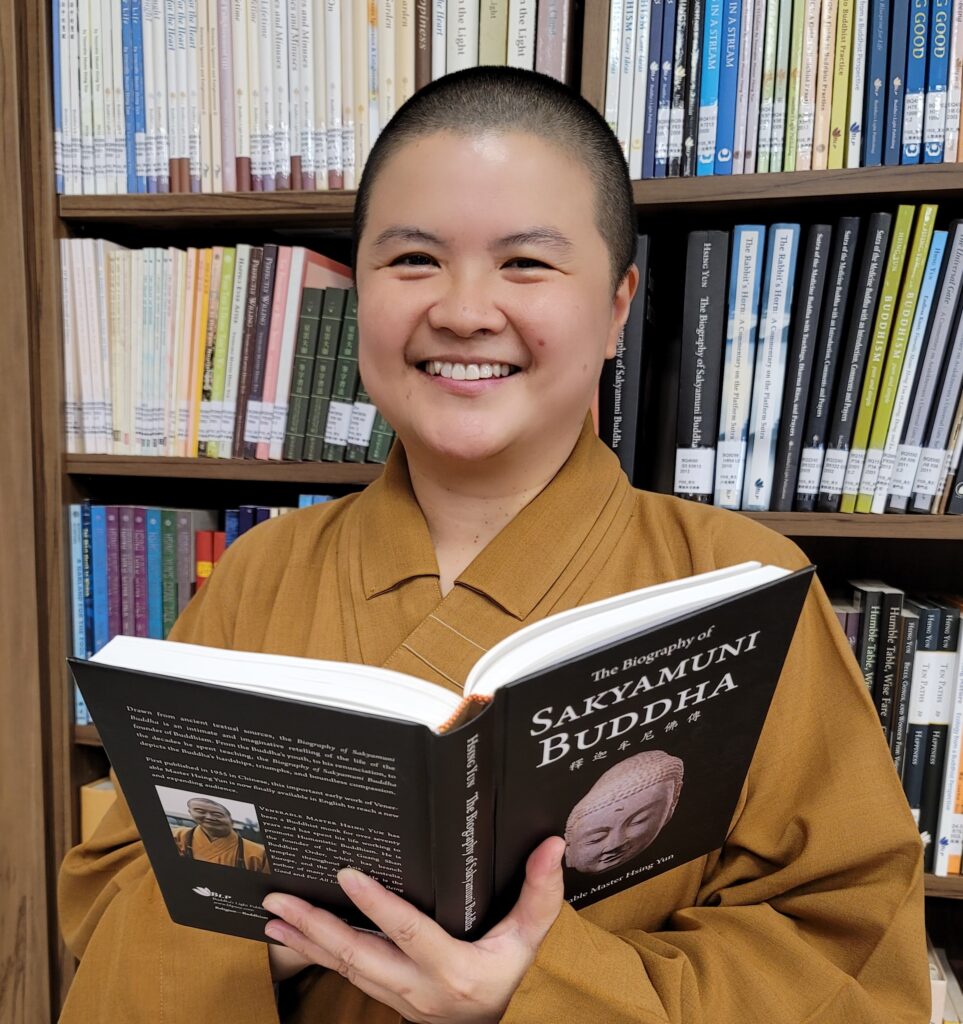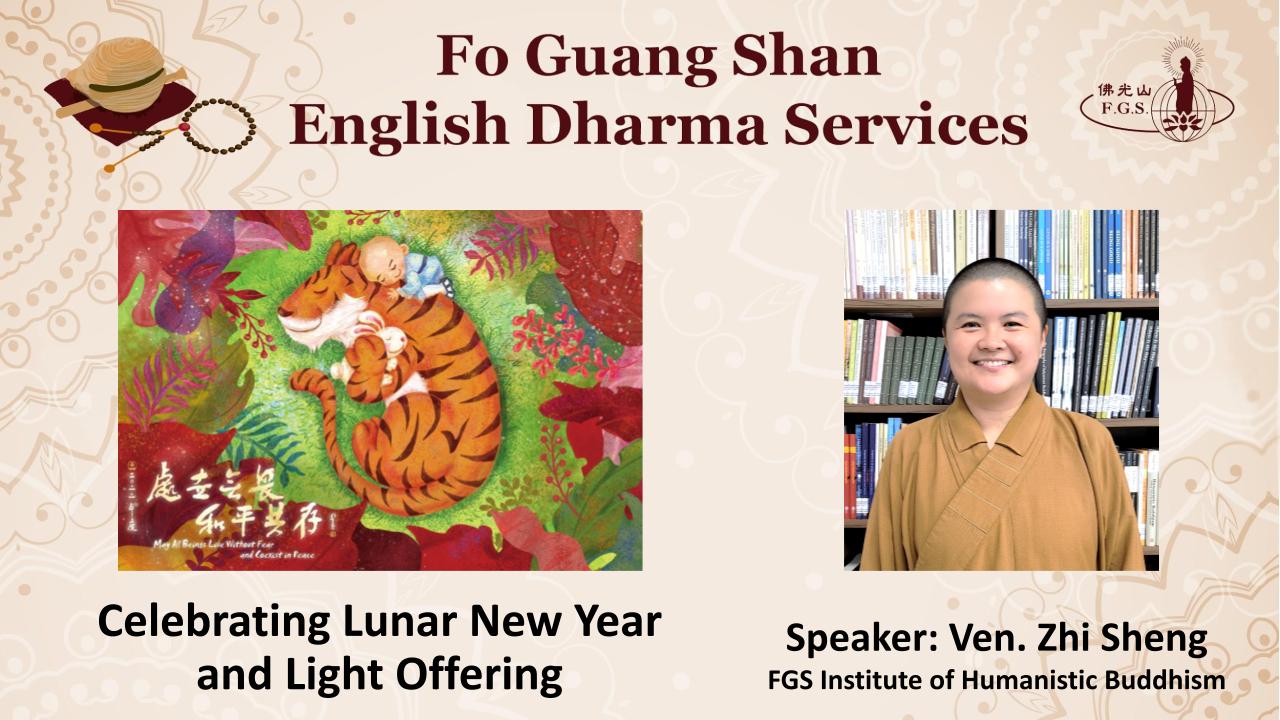
Venerable Zhi Sheng
Fo Guang Shan Institute of Humanistic Buddhism
I. Introduction
Auspicious Blessings to you. Happy Lunar New Year!
Hello, welcome to the Fo Guang Shan English Dharma Services. My name is Zhi Sheng.
Today, I would like to continue with the theme of Lunar New Year and discuss what are some of the traditions of Lunar New Year and how they have been implemented by Venerable Master Hsing Yun. Also, for the latter part, we shall look at the significance of Light Offering which is also a part of the celebration at Fo Guang Shan.
II. Lunar New Year Traditions
First of all, have you ever wondered about why the Chinese celebrate the Lunar New Year the way they do? Why do they put up red decorations and have firecrackers?
Food is one of the highlights of the Lunar New Year. There is a lot of thought put into the menu for this very important holiday of the year. The dishes are created to give blessings for the next year. Both the names and looks are symbols of wishes for prosperity, happiness, and auspiciousness.
- Dumplings 餃子 (jiǎo zi) sounds like 交子 (jiāo zi). 交 (Jiāo) which means “exchange” and 子 (zi) is the midnight hour. Put together, jiāo zi is the exchange between the old and new year. By eating dumplings, you are sending away the old and welcoming the new.
- Turnip Cake 蘿蔔糕 (luó bo gāo). In Chinese, “radish” (菜头 / cài tóu) has a similar pronunciation as “good luck and fortune” (好彩头).
- Nian gao 年糕 (nián gāo) also has the same pronunciation as 高 (gāo, meaning tall or high). It’s a wish to be successful and “higher” each year. Every year will be better than the last. Some humorous parents like to tell their children that eating this will help them grow taller too.
- Rice Balls湯圓 (tāng yuán). Just like the beginning of the Spring Festival, family reunion is the main focus of this festival. No matter what name it goes by, it includes a word pronounced “yuan” (圓/元). Yuan can mean circle and also sounds similar to “reunions” (團圓 / tuán yuán).
The Lunar New Year is a time of family gathering. Usually, the New Year’s Eve dinner (年夜飯 / Nián yèfàn) or Reunion dinner (團年飯 / tuán niánfàn) is extremely important to the Chinese. All family members must go home for dinner, so that we are together or reunited as the given name.
III. Legend of Nian
The Legend has it that, once upon a time, there lived a monster named Nián (年) that lived at the bottom of the sea. It would come up to the shore once a year to feast on animals and humans. On the day of New Year’s Eve, people in the village would escape into the mountains.
One year, a beggar came to seek shelter, but everyone was hurrying away. Only an old woman was willing to take him in. The beggar promised the old woman that he could chase Nian away. He then began to decorate the homes in the village.
At midnight, the monster Nian waddled in but stopped short when it saw the red papers on the doors. It then roared in anger, and firecrackers suddenly sounded. Nian trembled in fear. When it saw the beggar, dressed in red, and laughing at it, it could only run away.
When people in the village returned the next day, they were pleasantly surprised that the homes were all still standing. They realized that loud noises and the color red were Nian’s kryptonite.
This is why, on New Year’s Eve, everyone goes home for dinner to hide away from the monster Nian, and preparing a feast with offerings to the ancestors, hoping for the best. Everyone’s homes have red decorations. Firecrackers are lit at midnight. In addition, people wear new and festive red clothing to celebrate
IV. Spring Festival Couplets
The Lunar New Year is also called the Spring Festival, which is a time of change and new beginnings. Basically every activity during the Spring Festival has the purpose of removing the old and welcoming the new.
In terms of the red decorations, one of which that Chinese people love is Spring Festival couplet poems (春聯 / chūn lián). They are pasted on both sides of the doorframe.
The Spring Festival couplets have been implemented by Venerable Master Hsing Yun. In 1996, he wrote “Peaceful and Auspicious” as a greeting for the Lunar New Year. In 1997, “Harmony and Happiness. In 1998, “Wholeness and Freeness,” and so on. Since then, he composed these new year couplets as gifts to all devotees.
In 2007, the Venerable Master began drawing inspiration from the Chinese Zodiac for his couplets. Just naming a few for example, in 2009, it was the year of Ox, Venerable Master wrote “Earnest Cultivation Yields Fruitful Harvests.” In 2012, it was the year of Dragon, and he wrote “Heavenly Blessings and Protection.”
Just a brief introduction of the Chinese Zodiac. It is a repeating 12-year cycle of animal signs and their ascribed attributes, based on the lunar calendar. In order, the zodiac animals are: Rat, Ox, Tiger, Rabbit, Dragon, Snake, Horse, Goat, Monkey, Rooster, Dog, Pig. The Lunar New Year, or Spring Festival, marks the transition from one animal to the next.
Legend has it that the Jade Emperor summoned all the animals to his palace in a “Great Race,” and the order in which they arrived determined the animal’s place in the zodiac.
The Spring Festival, being the most important holiday, is infused with cultural essence. Venerable Master Hsing Yun composes the Lunar New Year couplets in hopes to revive the inherent virtue of Chinese culture. While everyone eagerly awaits the Lunar New Year, the couplet written on red paper serves as an inspiration and a complement to worldly joy and delight instead of solely focusing on the spectacles and frivolities. Let us now look at a few examples in more detail.
The year 2016, according to the Chinese animal zodiac, belongs to the Year of Monkey.
“Monkeys are smart and agile. We often see monkeys performing many different feats that bring joy to onlookers. In this world, giving others joy is a crucial form of giving. So for this coming year, I hope that all members of Fo Guang Shan and people around the world will practice being smart and agile like the wise Monkey King.”
For the Year of Dog in 2018, Venerable Master wrote “A Family Legacy of Loyalty and Honor.”
“Loyalty and honor are most important in life. We must stay loyal in our relationships, responsibilities, friendships, and towards our leaders. It is essential to understand, be grateful for, realize, and keep as family legacy the spirits of loyalty and honor.”
For the Year of Pig in 2019, Venerable Master wrote “Always Well-rounded and Auspicious.”
Pig is an animal that symbolizes a way to round up the year and start anew in life. One homonym for ‘pig’ in Chinese is “all” or “everything,” (諸) which also represents a good wish for all to have a well-rounded and auspicious year.
IV. Lunar New Year and Light
According to the Chinese, lanterns are lit on the 15th day of the Lunar New Year and extinguished on the 18th. Scores are settled on the 19th and journeys are begun on the 20th.
In Taiwanese folklore, Temple fairs are also a feature, whereby on the 15th day of the Lunar New Year, Lantern Festivals and Lantern Parades are held.
During the Lantern Festival, children go out at night carrying paper lanterns and solve riddles on the lanterns.
[Slide #21]
Each year since 1980, the “New Year Festival of Light and Peace” is held at Fo Guang Shan, where the lanterns remain lit for one month. This is an innovation of the Dharma propagation by Venerable Master Hsing Yun.
A Light Offering is one of the Ten Offerings in Buddhism, and are conducted by Buddhist temples in the form of a Light Offering Dharma Service during the Lunar New Year.
The light from a single lamp can, in an instant, dispel the darkness that has prevailed for thousands of years. The light symbolizes brightness and wisdom.
The Avatamsaka Sutra states, “The light of wisdom can expel all darkness.”
Why do we offer light? Akin to the fire in a stove that cooks food and keeps it warm, the light can dispel darkness and bring people warmth.
The Buddha is the light that makes us brighter, brings us warmth, and offers refuge. With the Buddha’s light in our hearts, we are guided on the path to becoming sages and buddhas, kindling growth and realization.
When making a light offering to the Buddha, it is of greater importance to illuminate the light within. All buddha lands are infinitely bright for there is no darkness within the minds of the buddhas. Making a light offering is not merely an offering, but also sheds light on our right mindfulness and faith.
Have you given rise to faith? To have faith is to affirm our buddha-nature. Without faith, the light within us is unlit. Once our inner light is sparked, we must add oil to fuel it. This applies to many things in this world as well. For example, when the oil in a car is refilled, it can keep moving.
In Buddhism, to add oil means to rejoice and practice generosity as well as wholesome and virtuous deeds. Once our faith and merit are fulfilled our inner light will shine clearer and brighter than even sunlight or moonlight, illuminating every corner of the universe. When our inner light is lit, our buddha-nature is revealed, and our mind is filled with brightness and purity. Only then can loving-kindness, compassion, and wisdom arise.
In the time of the Buddha, sages that possessed superknowledge radiated light, for it was their virtuous deeds that earned the respect and reverence of the people. The Buddha and sages radiating light reminds us to emulate them, to practice self-awareness, and strive to shine our inner light so that we may also radiate light throughout our lives.
In our daily lives, let our mouths shine by speaking good words; let our eyes shine by acknowledging and treating people with loving-kindness; let our hands shine by doing good deeds. If everyone can shine with the lights of loving-kindness, compassion, and prajna wisdom, not only are we illuminating others, we will also be illuminating ourselves.
IV. Conclusion
In closing for today’s session, I call on everyone to find themselves under the lamp of hope.
Thank you so much for listening! May you find peace and joy in the Dharma.
If you would like to listen to more content, don’t forget to subscribe to our channel, Fo Guang Shan English Dharma Services.

